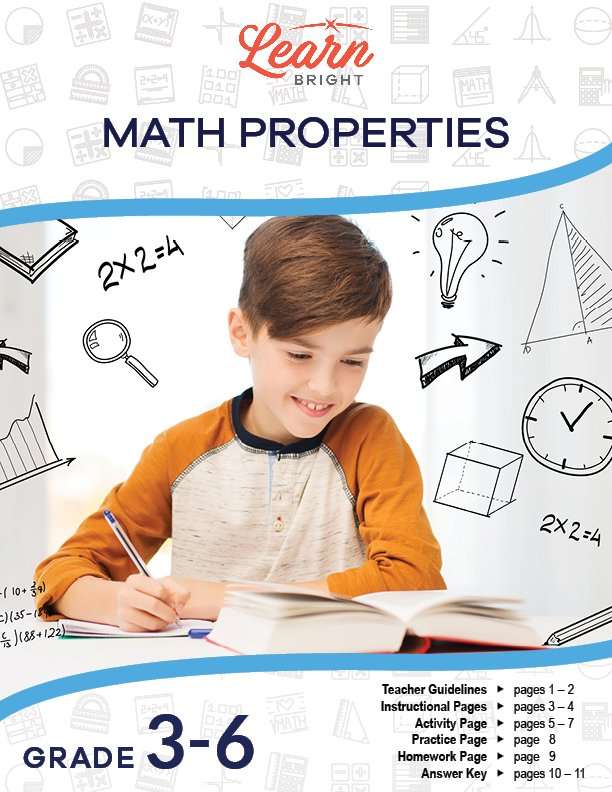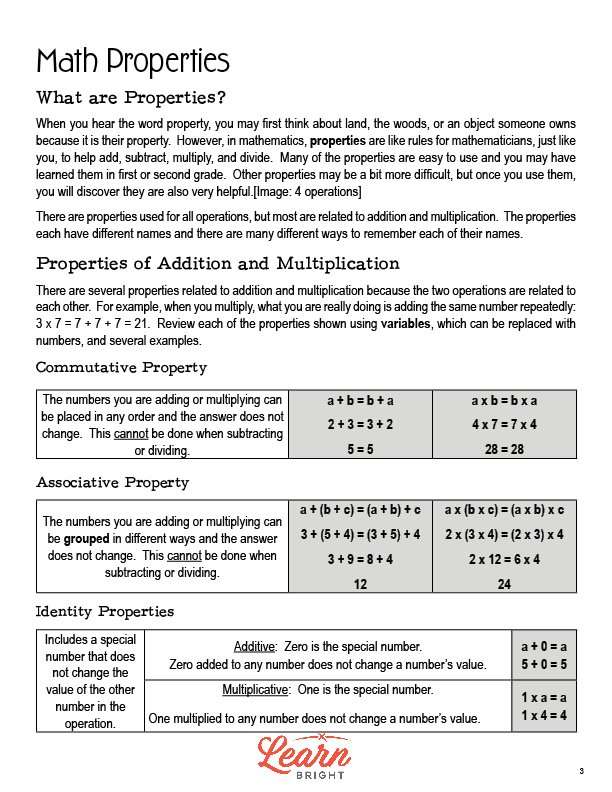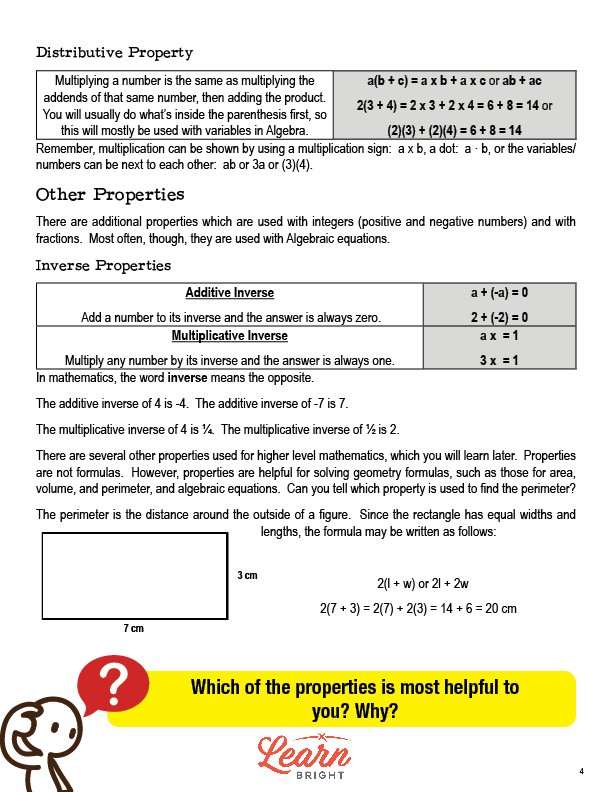Description
What our Math Properties lesson plan includes
Lesson Objectives and Overview: Math Properties explores several different math properties. At the end of the lesson, students will be able to identify and use several math properties including the Commutative/Associative Properties of Addition and Multiplication, Distributive Property, Additive and Multiplicative Identity/Inverse Properties. This lesson is for students in 3rd grade, 4th grade, 5th grade, and 6th grade.
Classroom Procedure
Every lesson plan provides you with a classroom procedure page that outlines a step-by-step guide to follow. You do not have to follow the guide exactly. The guide helps you organize the lesson and details when to hand out worksheets. It also lists information in the blue box that you might find useful. You will find the lesson objectives, state standards, and number of class sessions the lesson should take to complete in this area. In addition, it describes the supplies you will need as well as what and how you need to prepare beforehand. The supplies that you will need for this lesson includes scissors and the handouts.
Options for Lesson
Included with this lesson is an “Options for Lesson” section that lists a number of suggestions for activities to add to the lesson or substitutions for the ones already in the lesson. One optional adjustment to the lesson activity is to have your students create additional problems for other students to solve. If you’d like to add an additional activity to this lesson, you can assign different groups of students a property and have them create a large creative poster for display in the room; the posters should display pneumonic devices to help students remember the name of the property. Finally, if you’d like, you can use the practice or homework pages as quizzes.
Teacher Notes
The teacher notes page includes a paragraph with additional guidelines and things to think about as you begin to plan your lesson. This page also includes lines that you can use to add your own notes as you’re preparing for this lesson.
MATH PROPERTIES LESSON PLAN CONTENT PAGES
What are Properties?
The Math Properties lesson plan includes two content pages. When you first hear the word property, you might think of an object or piece of land someone owns, also known as their property. However, in mathematics, properties are something else entirely! Mathematical properties are rules for mathematicians that help you add, subtract, multiply, and divide. Many properties are very easy to use, while others are a little more difficult. No matter the difficulty, all of them are very helpful!
We have properties for all operations, but most of them are for addition or multiplication. Each property has its own name.
Properties of Addition and Multiplication
Several properties relate to addition and multiplication because these two operations are related to each other. When you multiply, you’re really just adding the same number multiple times. 3 x 7, for example, is the same as 7 + 7 + 7. Each of the properties covered in this lesson include variables, which can be replaced with numbers.
Commutative Property
The Commutative Property states that the numbers you add or multiply can be placed in any order and the answer does not change. This cannot be done when subtracting or dividing.
For addition, a + b = b + a. For multiplication, a x b = b x a. The lesson includes examples with numbers instead of variables.
Associative Property
The Associative Property states that the numbers you add or multiply can be grouped in different ways and the answer does not change. This cannot be done when subtracting or dividing.
For addition, a + (b + c) = (a + b) + c. For multiplication, a x (b x c) = (a x b) x c. The lesson includes examples with numbers instead of variables.
Identity Properties
Identity properties include a special number that does not change the value of the other number in the operation.
For addition, zero is the special number. When you add zero to any number, it does not change that number’s value: a + 0 = a. For multiplication, one is the special number. When you multiply any number by one, it does not change that number’s value: 1 x a = a. The lesson includes examples with numbers instead of variables.
Distributive Property
The Distributive Property states that multiplying a number is the same as multiplying the addends of that same number, then adding the product. You will usually do what’s inside the parenthesis first, so you will mostly use this with variables in Algebra.
The property shown with variables is: a(b + c) = a x b + a x c or ab + ac. The lesson includes an example with numbers instead of variables.
When working with properties, always remember that multiplication can be shown by using a multiplication sign: a x b, a dot: a · b, or with variables/numbers next to each other: ab, 3a, or (3)(4).
Other Properties
Some other properties are used with integers (positive and negative numbers) and with fractions. Most often, though, they are used with Algebraic equations.
Inverse Properties
The Additive Inverse Property states that when you add a number to its inverse, the answer is always zero: a + (-a) = 0.
The Multiplicative Inverse Property states that when you multiply any number by its inverse, the answer is always one: a x (-a) = 1.
In math, the word inverse means opposite. For example, the additive inverse of 4 is -4 and the additive inverse of -7 is 7. The multiplicative inverse of 4 is 1/4 and the multiplicative inverse of 1/2 is 2.
There are many other mathematical properties which we use in higher level mathematics, but it’s not time to learn them yet! Properties are not formulas, but are helpful for solving geometry formulas like those for area, volume, and perimeter, and algebraic equations.
For example, perimeter is the distance around the outside of a figure. Since the rectangle has equal widths and lengths, the formula may be written as follows: 2(l + w) or 2l + 2w. What property does this formula use?
MATH PROPERTIES LESSON PLAN WORKSHEETS
The Math Properties lesson plan includes three worksheets: an activity worksheet, a practice worksheet, and a homework assignment. You can refer to the guide on the classroom procedure page to determine when to hand out each worksheet.
CREATING PROBLEMS ACTIVITY WORKSHEET
The activity worksheet asks students to create two examples for each property by manipulating digits and symbols that they cut out from the worksheet. They will solve each of the problems that they create by writing in the answer using the blank rectangles provided. Next, they will rewrite their problems in the spaces provided for each property. Finally, they will exchange their problems with another student to have them checked for accuracy.
MATCHING PRACTICE WORKSHEET
For the practice worksheet, students will first match each property to its example. They will then create an example of each property with the given digits and solve. For example, for the additive identity property, they must include the number 7.
MATH PROPERTIES HOMEWORK ASSIGNMENT
The homework assignment asks students to answer 12 multiple choice questions about the lesson material.
Worksheet Answer Keys
This lesson plan includes answer keys for the practice worksheet and the homework assignment. If you choose to administer the lesson pages to your students via PDF, you will need to save a new file that omits these pages. Otherwise, you can simply print out the applicable pages and keep these as reference for yourself when grading assignments.









